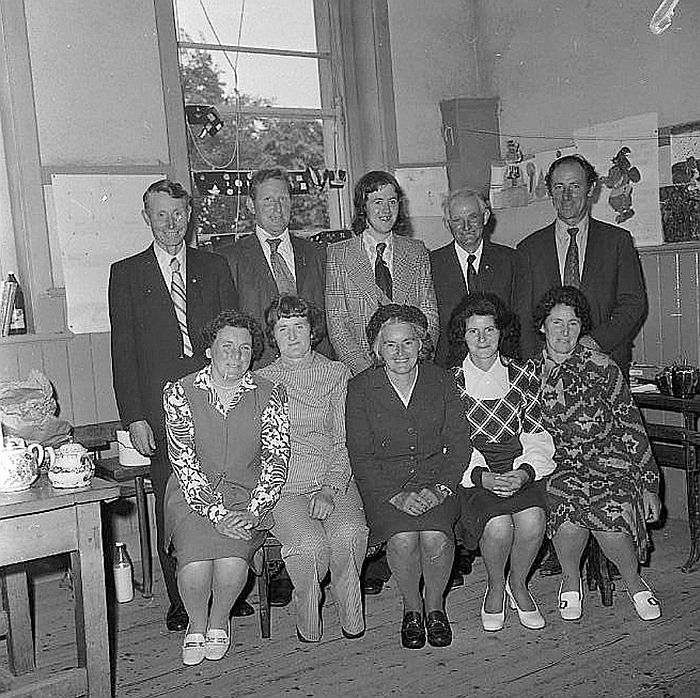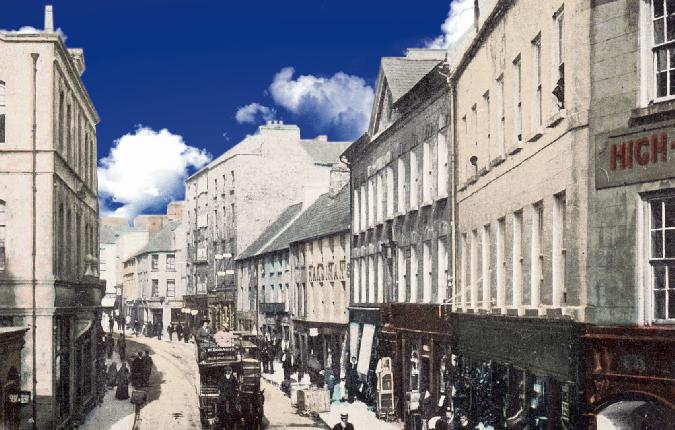Archive News
July 22, 2010

Date Published: {J}
Policeman charged
At the resumption of the business of the Galway Summer Assizes at half-past 10 o’clock on Tuesday, a Constable of the Royal Irish Constabulary pleaded “not guilty” to an indictment charging him with commiting a rape upon an old woman of 74 years of age, of the 28th April last.
Mr. Fetherstonhaugh, K.C. and Mr. Coll (instructed by Mr. Blake C.S.) prosecuted for the Crown, and Mr. Macdermot (instructed by Mr. O’Dea solr) defended.
The story told by the prosecutrix, who is a widow residing alone at Rosdullis, was to the effect that prisoner came to her house whilst she was in bed, shortly after 12 o’clock on the night of 22nd April, threatened to break in the door and to burn the house.
He was in uniform and when she opened the door, he blew out the candle and assaulted her. Walking to the dock, she identified the prisoner as the man, after having first looked all round the Court.
Dr. Kennedy found no marks on [the alleged injured party] to indicate that an assault had been committed, as alleged.
For the defence, a number of policemen gave evidence to the effect that the prisoner returned from patrol at 11.30 o’clock on the night in question and went to bed. They expressed the belief that he could not have left the barracks subsequently without their knowledge. He did not sign the patrol book, although it is his duty to do so.
Prisoner was sworn and emphatically denied the assault. He forgot to sign the patrol book. Lord Chief Kenny, in addressing the Jury, said the case was a mass of impossibilities from beginning to end. The evidence given by the doctor, who was a Crown witness, was entirely in favour of the defendant. He found no marks on the woman. He asked the Jury to bring in a verdict of “not guilty”.
His Lordship directed Co. Inspector Flower to inform the constabulary authorities that the evidence given should not prejudice them against the constable. The prisoner was acquitted.
Mysterious vehicle
On Saturday evening, a strange vehicle pulled up at Fox’s public house in Church Street, Athenry, and many pedestrians halted to inspect it. On both sides police with rifle kept guard, while another man remained at the horse’s head. From inquiries I ascertained that it was one of Mr. Martin McDonough’s Monatigue transport cars which had come in with the thirsty emergencymen from Galway, who were saving the hay.
1935
Pool calls
The drowning tragedy in the River Suck on Sunday evening, when a young man in the town lost his life through sad circumstances there, calls attention once again to the need of a properly supervised pool.
Some time ago the provision of such was discussed when application for a grant to the Department for Local Government was made. The project, however, was allowed to drop and since then nothing has been heard of it.
Each year when summer comes round, the dangers to children swimming in the river are again the subjects of discussion, but it is only when tragedy occurs that the need for such a pool is emphasised. Numbers of young children may be seen any day risking their lives in parts of the Suck where there are dangerous currents, and where it is impossible to have any proper supervision over them.
Evictions
The eviction of eight families with their thirteen children, all young, from their homes in Kelly’s Lane, Ballinasloe, on Saturday evening, goes to show the pressing needs for more and more houses to accommodate the large number of congests in lanes and other areas on the town.
There are not nearly enough of houses in the town to accommodate the number needing houses, although the Council have, during the past few years, built up over 100 houses, 60 at present being in the course of construction.
Those eight families, however, evicted on Saturday night, will not be provided for in the houses when available as these houses are built for tenants in another condemned area, so that the eight families and the children who have been provided with temporary shelter in the disused and derelict wing of the fever ward at the old workhouse buildings will be compelled to remain in these unsuitable surroundings for an indefinite period, all housed together in one small building.
New road
Between 50 and 60 men are employed by the Galway Co. Council in the making of the cement road from Tuam to the Beet Factory. We understand that at the meeting of the Co. Council on Saturday, a motion will be put forward proposing that the rate of wages paid to labourers on this job (the present rate is 27s. a week) shall be increased.
For more, read this week’s Connacht Tribune.
Galway in Days Gone By
The way we were – Protecting archives of our past

People’s living conditions less than 100 years ago were frightening. We have come a long way. We talk about water charges today, but back then the local District Councils were erecting pumps for local communities and the lovely town of Mountbellew, according to Council minutes, had open sewers,” says Galway County Council archivist Patria McWalter.
Patria believes we “need to take pride in our history, and we should take the same pride in our historical records as we do in our built heritage”. When you see the wealth of material in her care, this belief makes sense.
She is in charge of caring for the rich collection of administrative records owned by Galway County Council and says “these records are as much part of our history as the Rock of Cashel is. They document our lives and our ancestors’ lives. And nobody can plan for the future unless you learn from the past, what worked and what didn’t”.
Archivists and librarians are often unfairly regarded as being dry, academic types, but that’s certainly not true of Patria. Her enthusiasm is infectious as she turns the pages of several minute books from Galway’s Rural District Councils, all of them at least 100 years old.
Part of her role involved cataloguing all the records of the Councils – Ballinasloe, Clifden, Galway, Gort, Loughrea, Mountbellew, Portumna and Tuam. These records mostly consisted of minutes of various meetings.
When she was cataloguing them she realised their worth to local historians and researchers, so she decided to compile a guide to their content. The result is For the Record: The Archives of Galway’s Rural District Councils, which will be a valuable asset to anybody with an interest in history.
Many representatives on these Councils were local personalities and several were arrested during the political upheaval of the era, she explains.
And, ushering in a new era in history, women were allowed to sit on these Rural District Councils – at the time they were not allowed to sit on County Councils.
All of this information is included in Patria’s introductory essay to the attractively produced A4 size guide, which gives a glimpse into how these Rural Councils operated and the way political thinking changed in Ireland during a short 26-year period. In the early 1900s, these Councils supported Home Rule, but by 1920, they were calling for full independence and refusing to recognise the British administration.
“I love the tone,” says Patria of the minutes from meetings. “The language was very emotive.”
That was certainly true of the Gort Rural District Council. At a meeting in 1907, following riots in Dublin at the premiere of JM Synge’s play, The Playboy of the Western World the councillors’ response was vehement. They recorded their decision to “protest most emphatically against the libellous comedy, The Playboy of the Western World, that was belched forth during the past week in the Abbey Theatre, Dublin, under the fostering care of Lady Gregory and Mr Yeats. We congratulate the good people of Dublin in howling down the gross buffoonery and immoral suggestions that are scattered throughout this scandalous performance.
For more from the archives see this week’s Tribunes here
Archive News
Galway have lot to ponder in poor show

Date Published: 23-Jan-2013
SLIGO 0-9
GALWAY 1-4
FRANK FARRAGHER IN ENNISCRONE
GALWAY’S first serious examination of the 2013 season rather disturbingly ended with a rating well below the 40% pass mark at the idyllic, if rather Siberian, seaside setting of Enniscrone on Sunday last.
The defeat cost Galway a place in the FBD League Final against Leitrim and also put a fair dent on their confidence shield for the bigger tests that lie ahead in February.
There was no fluke element in this success by an understrength Sligo side and by the time Leitrim referee, Frank Flynn, sounded the final whistle, there wasn’t a perished soul in the crowd of about 500 who could question the justice of the outcome.
It is only pre-season and last Sunday’s blast of dry polar winds did remind everyone that this is far from summer football, but make no mistake about it, the match did lay down some very worrying markers for Galway following a couple of victories over below par third level college teams.
Galway did start the game quite positively, leading by four points at the end of a first quarter when they missed as much more, but when Sligo stepped up the tempo of the game in the 10 minutes before half-time, the maroon resistance crumbled with frightening rapidity.
Some of the statistics of the match make for grim perusal. Over the course of the hour, Galway only scored two points from play and they went through a 52 minute period of the match, without raising a white flag – admittedly a late rally did bring them close to a draw but that would have been very rough justice on Sligo.
Sligo were backable at 9/4 coming into this match, the odds being stretched with the ‘missing list’ on Kevin Walsh’s team sheet – Adrian Marren, Stephen Coen, Tony Taylor, Ross Donovan, David Kelly, David Maye, Johnny Davey and Eamon O’Hara, were all marked absent for a variety of reasons.
Walsh has his Sligo side well schooled in the high intensity, close quarters type of football, and the harder Galway tried to go through the short game channels, the more the home side bottled them up.
Galway badly needed to find some variety in their attacking strategy and maybe there is a lot to be said for the traditional Meath style of giving long, quick ball to a full forward line with a big target man on the edge of the square – given Paul Conroy’s prowess close to goal last season, maybe it is time to ‘settle’ on a few basics.
Defensively, Galway were reasonably solid with Gary Sice at centre back probably their best player – he was one of the few men in maroon to deliver decent long ball deep into the attacking zone – while Finian Hanley, Conor Costello and Gary O’Donnell also kept things tight.
For more, read this week’s Connacht Tribune.
Archive News
Real Galway flavour to intermediate club hurling battle in Birr

Date Published: 23-Jan-2013
images/files/images/x3_Courthouse.jpg










